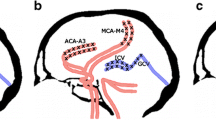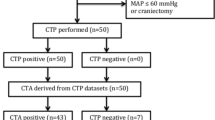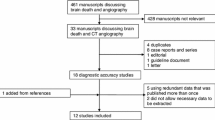Abstract
Background
Late-phase images on computed tomography angiography (CTA), traditionally used for assessing cerebral circulatory arrest in brain death, suffer from suboptimal diagnostic yield due to stasis filling. Herein, we assessed contrast filling in individual intracranial arteries and veins in the early and late phases of CTA in patients with clinically confirmed brain death.
Methods
Contrast opacification within 28 arterial/venous segments was evaluated in both phases of CTA in 79 patients. This information was combined with reports in the literature to calculate prevalence of contrast filling in different intracranial vessels. Additionally, diagnostic sensitivity of 4-point, 7-point, and 10-point scores defined for brain death were compared among ratings based on early, late, and both phases (arteries rated on early, veins rated on late phase) of imaging.
Results
The median (IQR) number of vessel segments with contrast opacification was 0 (0–2) in early phase and 6 (0–10) in late phase. All segments showed increased prevalence of opacification when evaluated in late phase (p < 0.05). The M4 segments of MCA, internal cerebral veins, and vein of Galen had the lowest percentage of opacification in both phases. The sensitivity of 4-, 7-, and 10-point scoring algorithms increased from 59–91% to 94–99% when ratings were performed using early-phase images rather than based solely on late-phase images.
Conclusions
The incorporation of early-phase images might be considered as a strategy to improve the sensitivity of CTA as an ancillary test in confirming brain death, especially in patients without missing or questionable elements in clinical examination.

Similar content being viewed by others
References
Lewis A, Bakkar A, Kreiger-Benson E et al (2020) Determination of death by neurologic criteria around the world. Neurology 95:e299–e309
Greer DM, Wang HH, Robinson JD et al (2016) Variability of brain death policies in the United States. JAMA Neurol 73:213–218
Greer DM, Shemie SD, Lewis A et al (2020) Determination of brain death/death by neurologic criteria: the world brain death project. JAMA 324:1078–1097
Berenguer CM, Davis FE, Howington JU (2010) Brain death confirmation: comparison of computed tomographic angiography with nuclear medicine perfusion scan. J Trauma 68:553–559
Bohatyrewicz R, Sawicki M, Walecka A et al (2010) Computed tomographic angiography and perfusion in the diagnosis of brain death. Transplant Proc 42:3941–3946
Brasil S, Bor-Seng-Shu E, M. de-Lima-Oliveira, et al (2016) Role of computed tomography angiography and perfusion tomography in diagnosing brain death: a systematic review. J Neuroradiol 43:133–140
Brasil S, Bor-Seng-Shu E, de-Lima-Oliveira M et al (2019) Computed tomography angiography accuracy in brain death diagnosis. J Neurosurg. https://doi.org/10.3171/2019.6.Jns191107:1-9
Combes JC, Chomel A, Ricolfi F et al (2007) Reliability of computed tomographic angiography in the diagnosis of brain death. Transplant Proc 39:16–20
Dupas B, Gayet-Delacroix M, Villers D et al (1998) Diagnosis of brain death using two-phase spiral CT. AJNR Am J Neuroradiol 19:641–647
Escudero D, Otero J, Marqués L et al (2009) Diagnosing brain death by CT perfusion and multislice CT angiography. Neurocrit Care 11:261–271
Frampas E, Videcoq M, de Kerviler E et al (2009) CT angiography for brain death diagnosis. AJNR Am J Neuroradiol 30:1566–1570
Garrett MP, Williamson RW, Bohl MA et al (2018) Computed tomography angiography as a confirmatory test for the diagnosis of brain death. J Neurosurg 128:639–644
Kramer AH, Roberts DJ (2014) Computed tomography angiography in the diagnosis of brain death: a systematic review and meta-analysis. Neurocrit Care 21:539–550
Leclerc X, Taschner CA, Vidal A et al (2006) The role of spiral CT for the assessment of the intracranial circulation in suspected brain-death. J Neuroradiol 33:90–95
Taylor T, Dineen RA, Gardiner DC et al (2014) Computed tomography (CT) angiography for confirmation of the clinical diagnosis of brain death. Cochrane Database Syst Rev. https://doi.org/10.1002/14651858.CD009694.pub2
Quesnel C, Fulgencio JP, Adrie C et al (2007) Limitations of computed tomographic angiography in the diagnosis of brain death. Intensive Care Med 33:2129–2135
Srairi M, Meluchova Z, Paoletti M et al (2020) Diagnostic accuracy of a revised computed tomography angiography score for brain death confirmation, combining supra-tentorial arteries and infra-tentorial veins. Eur J Radiol 130:109132
Marchand AJ, Seguin P, Malledant Y et al (2016) Revised CT angiography venous score with consideration of infratentorial circulation value for diagnosing brain death. Ann Intensive Care 6:88
Sawicki M, Bohatyrewicz R, Safranow K et al (2014) Computed tomographic angiography criteria in the diagnosis of brain death—comparison of sensitivity and interobserver reliability of different evaluation scales. Neuroradiology 56:609–620
Sawicki M, Sołek-Pastuszka J, Jurczyk K et al (2015) Original protocol using computed tomographic angiography for diagnosis of brain death: a better alternative to standard two-phase technique? Ann Transplant 20:449–460
Welschehold S, Kerz T, Boor S et al (2013) Computed tomographic angiography as a useful adjunct in the diagnosis of brain death. J Trauma Acute Care Surg 74:1279–1285
Welschehold S, Kerz T, Boor S et al (2013) Detection of intracranial circulatory arrest in brain death using cranial CT-angiography. Eur J Neurol 20:173–179
Welschehold S, Boor S, Reuland K et al (2012) CT angiography as a confirmatory test in brain death. Acta Neurochir Suppl 114:311–316
Nunes DM, Maia ACM, Boni RC et al (2019) Impact of Skull Defects on the Role of CTA for Brain Death Confirmation. Am J Neuroradiol 40:1177–1183
Arsava EM, Demirkaya S, Dora B et al (2014) Turkish neurological society—diagnostic guidelines for brain death. Turk J Neurol 20:101–104
Rieke A, Regli B, Mattle HP et al (2011) Computed tomography angiography (CTA) to prove circulatory arrest for the diagnosis of brain death in the context of organ transplantation. Swiss Med Wkly 141:w13261
Şahin H, Pekçevik Y (2015) CT angiography as a confirmatory test in diagnosis of brain death: comparison between three scoring systems. Diagn Interv Radiol 21:177–183
Ozpar R, Tonkaz M, Girgin NK et al (2021) Reliability of CT angiography scoring systems used for brain death and the effect of cranial interventions on the results. Clin Imaging 79:142–147
Zampakis P, Panagiotopoulos V, Kalogeropoulou C et al (2021) Computed tomography angiography scoring systems and the role of skull defects in the confirmation of brain death. Sci Rep 11:15081
Alvarez LA, Lipton RB, Hirschfeld A et al (1988) Brain death determination by angiography in the setting of a skull defect. Arch Neurol 45:225–227
Braun M, Ducrocq X, Huot JC et al (1997) Intravenous angiography in brain death: report of 140 patients. Neuroradiology 39:400–405
Akdogan AI, Pekcevik Y, Sahin H et al (2021) Assessment of cerebral circulatory arrest via CT angiography and CT perfusion in brain death confirmation. Korean J Radiol 22:395–404
Wijdicks EF (2010) The case against confirmatory tests for determining brain death in adults. Neurology 75:77–83
Petty GW, Mohr JP, Pedley TA et al (1990) The role of transcranial Doppler in confirming brain death: sensitivity, specificity, and suggestions for performance and interpretation. Neurology 40:300–303
Funding
This research did not receive any specific grant from funding agencies in the public, commercial, or not-for-profit sectors.
Author information
Authors and Affiliations
Corresponding author
Ethics declarations
Conflicts of interest
EMA receives honoraria from Fresenius Kabi, Bayer AG, Daiichi-Sankyo, Pfizer, Sanofi, Abbott, and Nutricia. He serves on the advisory boards of Abbott, Daiichi-Sankyo, Bayer AG, Pfizer, Fresenius Kabi, and Nutricia. MAT receives honoraria from Fresenius Kabi, Daiichi-Sankyo, Sanofi, and Abbott. He serves on the advisory boards for Abbott, Fresenius Kabi, Daiichi-Sankyo, and Pfizer. CAC, EG, SP, and KKO report no conflicts of interest.
Rights and permissions
About this article
Cite this article
Arsava, E.M., Ayvacioglu Cagan, C., Gumeler, E. et al. Comparison of early- and late-phase CT angiography findings in brain death. J Neurol 269, 5973–5980 (2022). https://doi.org/10.1007/s00415-022-11281-x
Received:
Revised:
Accepted:
Published:
Issue Date:
DOI: https://doi.org/10.1007/s00415-022-11281-x




